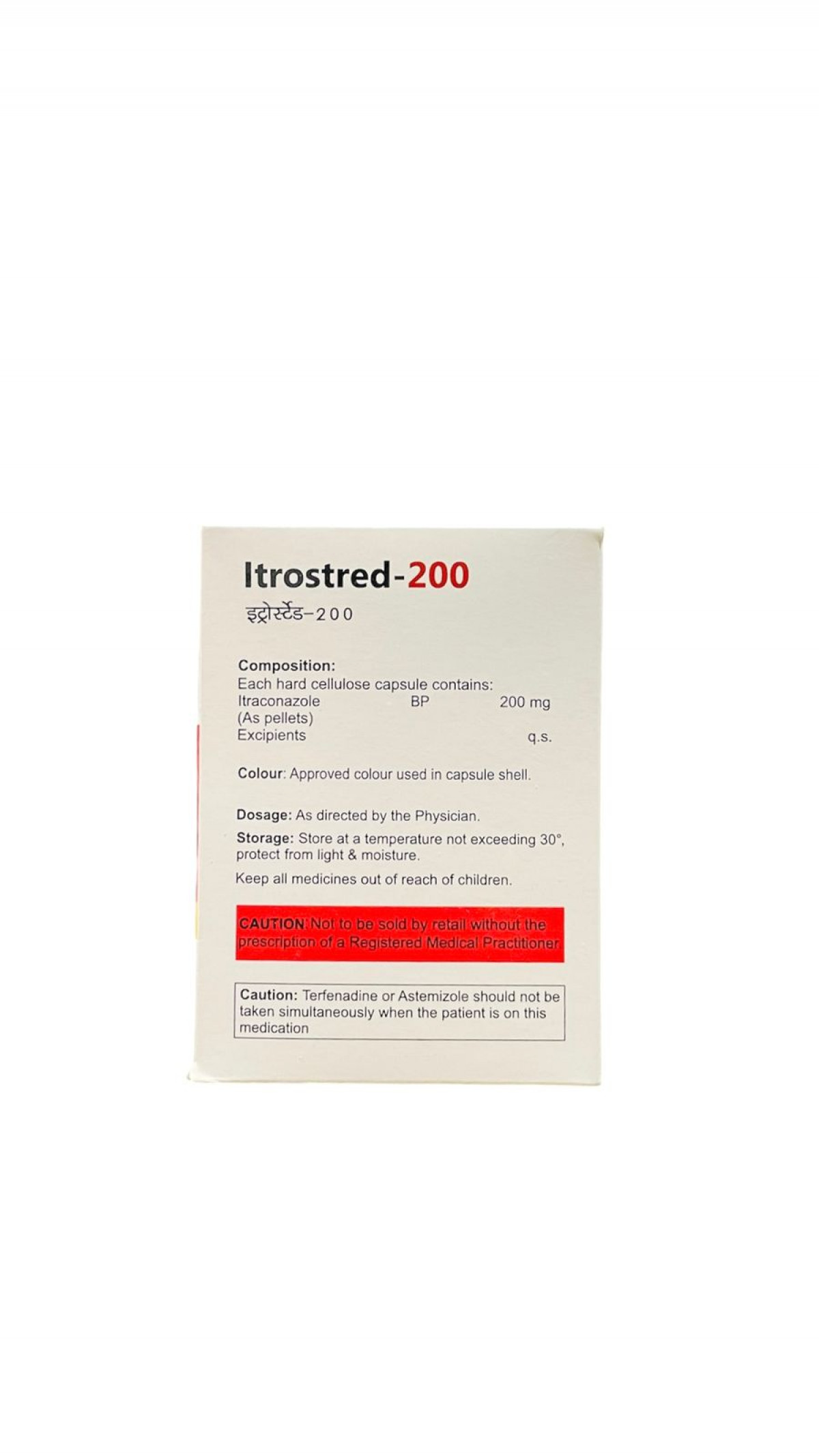ITROSTRED-200 CAPSULES 10's
Manufactured By Leeford Healthcare
Composition ltraconazole 200 mg (Blister)
Rs 145.15
MRP Rs 247.70
(41.4% OFF)
Includes all taxes
Package SIZE
( 1x10 CAPSULES )
100% Authentic
Products
Free
Shipping*
Products
Return Policy
Description:
Pregnancy Interaction
- Use during pregnancy: Itraconazole is not advised for use in pregnancy, especially during the first trimester, unless prescribed for severe or life-threatening fungal infections.
- Animal research indicates a possible risk to the developing fetus; data from human studies remain limited.
- Women of reproductive age must employ effective contraception throughout treatment and for a minimum of one menstrual cycle following the final dose.
- During breastfeeding, itraconazole may be excreted in minimal quantities in breast milk; administration should only occur under rigorous medical supervision.
How it works
- Itraconazole inhibits ergosterol synthesis, an essential component of fungal cell membranes, by targeting the enzyme lanosterol 14α-demethylase.
- The lack of ergosterol interferes with cell wall synthesis, resulting in the leakage of cellular contents and the subsequent demise of the fungal cell.
- It offers effective control over dermatophytes, yeasts (Candida spp.), and systemic fungi (Aspergillus, Histoplasma, and Blastomyces).
- Itraconazole accumulates in keratinized tissues (skin, nails, and hair), providing sustained protection even after the completion of therapy.
How to use
- Take the capsule precisely as prescribed by your healthcare professional.
- Ideally administered post-meal to enhance assimilation.
- Swallow the entire dose with a full glass of water—do not pulverize or chew.
- Administer at the same time each day to sustain consistent blood levels.
- Complete the entire prescribed regimen, even if symptoms resolve prematurely.
- If you neglect a dose, take it at the earliest opportunity unless it is nearly time for the subsequent dose—under no circumstances should you administer a double dose.
- Store below 30°C, protected from heat and humidity.
Uses/Indications
- Fungal cutaneous infections: ringworm (Tinea corporis), jock itch (Tinea cruris), and athlete’s foot (Tinea pedis).
- Fungal Nail Infections (Onychomycosis).
- Oral and vaginal candidiasis (thrush).
- Systemic mycoses: Histoplasmosis, Blastomycosis, and Aspergillosis.
- Seborrheic dermatitis and pityriasis versicolor (fungal dandruff).
- Recurrent or refractory fungal infections unresponsive to topical antifungal treatments.
Side Effects
Common:
- Nausea, vomiting, or abdominal discomfort.
- Headache or vertigo.
- Mild dermatological irritation or pruritus.
- Diarrhea or constipation.
Uncommon:
- Loss of appetite, abdominal congestion, or alterations in taste.
- Slight swelling of the ankles or feet due to fluid retention.
Serious (infrequent):
- Liver damage: jaundice of the conjunctiva and skin, dark urine, and fatigue (discontinue use immediately and notify your physician).
- Heart failure symptoms: chest discomfort, dyspnea, or peripheral edema.
- Severe allergic reactions: rash, facial edema, dyspnea (seek immediate medical attention).
Medicine Interaction
- Itraconazole has the potential to interact with various other medications. Always notify your physician of all medications you are currently using.
- Exercise caution or avoid entirely when using with:
- Antacids and acid-suppressing agents (such as omeprazole and pantoprazole) decrease the absorption of itraconazole.
- Rifampicin, carbamazepine, and phenytoin reduce the efficacy of itraconazole.
- Heart rhythm medications (quinidine, dofetilide, cisapride): potential for life-threatening arrhythmias.
- Statins (simvastatin, lovastatin): may elevate the risk of muscle toxicity.
- Oral contraceptives: may decrease efficacy; employ supplementary protection.
- Alcohol: refrain from consumption—it elevates the risk of liver toxicity.
Expert advice
- Always consume after meals for optimal absorption.
- Fulfill all components of the course as outlined.
- Refrain from consuming alcohol and antacids throughout the duration of the treatment.
- Promptly report any indications of liver impairment (such as vertigo, fatigue, or jaundice of the skin and eyes).
- Please notify your physician if you have a history of heart, kidney, or liver disease prior to commencing treatment.
- For extended use, such as in cases of nail infections, liver function tests (LFTs) may be recommended.
- Refrain from self-medication, and ensure it is kept out of the reach of children.
FAQs for Medicine?
Q1. What is the purpose of Itrostred-200?
It is used to treat fungal infections of the skin, nails, mouth, pharynx, and internal organs, including ringworm, vaginal candidiasis, and systemic mycoses.
Q2. Is Itrostred-200 considered safe for use during pregnancy?
No, it should not be administered during pregnancy unless specifically prescribed for severe infections in which the benefits surpass the potential risks.
Q3. Is it permissible to consume Itrostred-200 alongside food?
Yes, it is always recommended to consume this after meals to optimize absorption.
Q4. Is it permissible to consume alcohol while taking this medication?
No. Alcohol consumption elevates the risk of liver injury and should be abstained from.
Q5. What are the consequences of missing a dose?
Take it promptly upon remembrance unless your next dose is imminent. Omit the missing one—do not duplicate.
Q6. Does Itrostred-200 induce dizziness?
Yes, moderate dizziness may be experienced. Refrain from driving or operating machinery if you experience dizziness or light-headedness.
Q7. Is it appropriate to take Itrostred-200 concurrently with antacids?
Refrain from consuming antacids within two hours before or after this capsule, as they may diminish its absorption.
Q8. What is the recommended duration for taking Itrostred-200?
The duration is contingent upon the specific type of infection:
Skin infections: 1–4 weeks
Nail infections: a duration of 3 to 6 months
Systemic infections: in accordance with your physician's instructions
Q9. Is it safe to take Itrostred-200 alongside antibiotics?
Only when administered under medical supervision—itraconazole may interact with certain antibiotics.
Q10. Are medical examinations required while using this medication?
Certainly. For extended courses or frequent use, liver function tests may be recommended.




